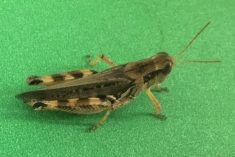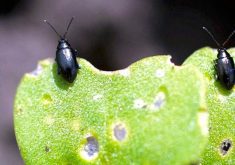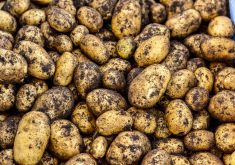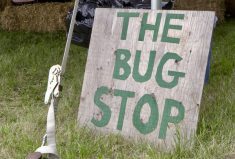Not all bugs are made equal and entomologist John Gavloski is warning producers of “collateral damage” in their beneficial insects.
“Certainly we’ve got insects that feed on the crops, but we’ve also got a lot of beneficial insects that feed on those insects that feed on the crops and when those are numerous, often the crop feeders are at low enough levels that we can kind of let the good guys, the beneficial insects, do the pest control for us,” Gavloski said.
The Manitoba Agriculture entomologist presented on the topic during the most recent CanoLAB canola management workshop March 15-16 in Dauphin.
Read Also

Still hard to predict precise fertilizer payback
Despite decades of advances, international research finds no clear answer for where and when adding nutrient will fail to boost growth.
Attendees were pitched on the benefits of parasitic wasps and flies (including major enemy species of bertha army worm and diamondback moth larvae), ground beetles (known to prey on a wide range of pest species and target weed seeds), ladybugs, hover flies and stiletto flies and other predatory insects.
Gavloski advised farmers to target spraying practices and apply product only when losses are nearing an economic threshold. He also argued for buffer zones around or near fields with natural growth, a practice he advocates for maintaining both beneficial predator and parasitic insects and pollinators.
“The more diverse flowering vegetation there is in an area, the better it is for these, not just pollinators, but parasitoids,” he said. “Parasitoids are a group of mainly flies and wasps that lay their eggs in other insects, but as adults often need nectar as a food source. A lot of parasitic wasps attack things like bertha army worms, diamondback moth, grasshoppers, a lot of our major pest species. As adults, they need nectar. Canola flowers for a very short period of time. It provides them with a very short, big burst of nectar, but before and after that, you still need nectar sources for these parasitoids. If you don’t, they will not live as long. They will not lay as many eggs. They will not parasitize as many insects.”
Decision points
There are no set population levels to determine when pesticide is not required, he said, although producers may look for parasitized pest species when determining management strategies.
Attendees were advised to look for blowhole-like wounds on bertha army worms, an indication that the parasitical tachinid fly has already laid eggs. Hatched larvae create the breathing hole in the back of the worm prior to emerging.
Parasitized aphids may also be identified by their bronzed colour on plants.
“If you’re well above threshold, you probably want to spray, but if you’re kind of borderline, toying with whether you should or not, sometimes that’s good information that can help out,” Gavloski said.
He pointed to previous research from Canada, the United States and Australia, which collectively showed an average 10-15 per cent yield increase in canola with the addition of pollinators such as bees. He cautioned, however, that actual yield increase may depend on the number of natural pollinators already present prior to insects being introduced.
Canola caution
While presented as part of a canola management workshop, the flea beetle, one of canola’s top insect pests, did not heavily feature.
“Flea beetles are very quick insects, so the effect of predators and parasitoids unfortunately probably isn’t as great on flea beetles as it is for some of the other pests,” Gavloski said.
Damsel bugs, lacewing larvae and big-eyed bugs are among those known to prey on flea beetles, although Gavloski warned the canola pest will make up only a small part of those insects’ diet.
“Unfortunately, the populations aren’t dropped the same way that we see it happen with something like bertha army worm. Because of that, we’re often caught in situations where you want a seed treatment on the plant to protect the canola on a pretty regular basis and, unfortunately, we do have a number of years where people, in addition, are doing full-year sprays for them. Even if you do have a seed treatment, you still have to be scouting your canola.”
Samples of crucifer and striped flea beetles were on display March 15-16.
Gavloski noted, however, that even some species of flea beetles may be beneficial.
Both the brown-legged spurge beetle and black dot spurge beetle have been introduced as a control for leafy spurge in various areas in the United States and Canada. According to the North Dakota Department of Agriculture, six spurge-controlling insects have been established since the 1980s, four of which are flea beetles.
Gavloski stressed that his talk covered only naturally occurring predatory and parasitical insects and had no bearing on insects purposefully introduced as a means of pest control.
















